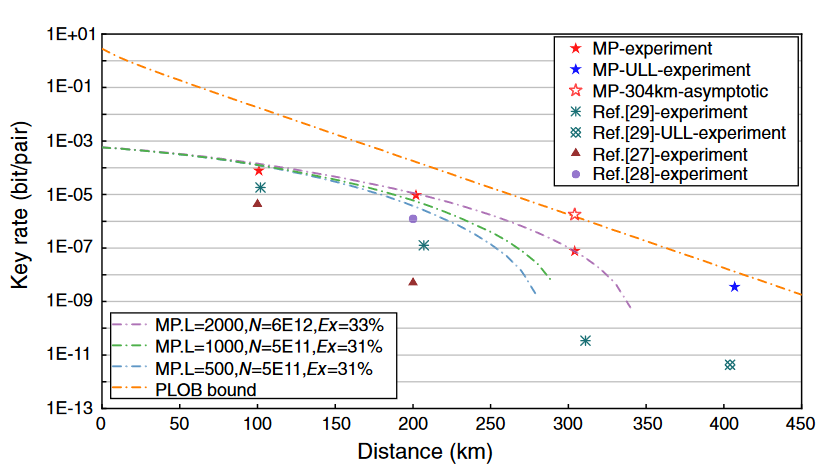Recently, Xiongfeng Ma's research group from Tsinghua University, in cooperation with Jian-Wei Pan and Teng-Yun Chen’s group from the University of Science and Technology of China, realized mode-pairing quantum key distribution in experiments for the first time, based on their proposed theoretical work of mode-pairing quantum key distribution.
Quantum key distribution (QKD) uses the basic principles of quantum physics to generate theoretically unconditionally secure random key bits for both communication parties, ensuring the security of information transmission. After years of theoretical and experimental technology development, QKD, especially those based on optical fiber channels, has entered the practical stage. The main bottleneck of the practical implementation of QKD networks lies in the exponential decay of the key rate with respect to the transmission distance. Tremendous efforts have been devoted to developing QKD schemes that can achieve higher key-rate improvement. Historically, the existing conventional BB84 and measurement-device-independent quantum key distribution (MDI-QKD) protocols cannot break through the linear bound determined by transmission loss, leading to a limited communication distance and performance. On the other hand, schemes like twin-field and phase-matching quantum key distribution enjoy a high key rate and long communication distances, at the cost of highly sensitive encoding to environmental noise. Consequently, one has to stabilize the phases between the lasers at the two user ends using global phase-locking techniques to realize these QKD schemes. Such techniques remain challenging when it comes to practical applications in metropolitan and intercity QKD networks. It remains to be the core task to overcome the transmission loss and improve the key rate and transmission distance for the theoretical and experimental research of quantum key distribution protocols.
To solve these problems, together with his student Pei Zeng, Hongyi Zhou, and Weijie Wu, Xiongfeng Ma proposed a new mode-pairing quantum key distribution (MP-QKD) protocol. The new protocol employs a hybrid encoding method to offer both high performance and simple implementation. As shown in Figure 1, in the MP scheme, Alice and Bob encode key information in a single optical pulse. After Charlie's announcement, they pair all the detected locations and generate raw key bits among each pair. The core observation of MP-QKD is that the two optical modes used to encode the relative information can be determined after Charlie's announcement. At the encoding and detecting stage, Alice and Bob only consider a single mode and do not require coincidence detection in predetermined locations. On the other hand, since the information is encoded in the relative information between the paired pulses, the encoding is more stable and can tolerate greater phase changes, so there is no need for complex long-distance phase-locking technology. Besides, the maximum pairing interval l can be adjusted according to the stability of the laser and the channel in the experiment. When l>1000, the key rate of the protocol can break through the linear bound; when l is above 10^4, the key rate is basically the same as that of the current one-mode protocols. Experimental verification shows that the MP scheme still has a low error rate when the maximum pairing interval l=10^4 without laser phase locking. Compared with the original measurement-device-independent protocol, MP-QKD utilizes more detection events, which can greatly improve the coding rate; compared with the two-field and phase-matching quantum key distribution protocols, MP-QKD does not require complicated laser frequency-locking and phase-locking technology, which saves cost and reduces the difficulty of practical application, and has better anti-interference ability against environmental noise.

Figure 1 Schematic diagram of the mode-pairing quantum key distribution protocol
Based on this theoretical scheme, Xiongfeng Ma and his doctoral student Yizhi Huang cooperated with the experimental team of the University of Science and Technology of China and successfully demonstrated the MP-QKD protocol using the high-efficiency single-photon detector developed by the Shanghai Institute of Microsystems of the Chinese Academy of Sciences. By developing a new phase reference estimation technique, they successfully implement the mode-pairing scheme with two independent off-the-shelf lasers. The system achieves a quadratic key-rate improvement over the conventional QKD schemes in the metropolitan and intercity scales. The implementation achieves a key rate over three orders of magnitude higher than that of MDI-QKD via 304km commercial-fiber channels and 407km ultra-low-loss fiber under the same experimental difficulty as traditional MDI-QKD. The results show that the implementation suits QKD networks, especially on metropolitan and intercity scales. In addition, the mode-pairing and phase-tracking technology developed in the experiment has potential applications in the quantum repeater, distributed quantum computation, and quantum internet.

Figure 2 Key rate of the MP-QKD protocol under different setting
Relevant research results were published in the international academic journal "Physical Review Letters" and reported by many media such as People's Daily and Science and Technology Daily. The co-first authors of this research paper are Haotao Zhu, a doctoral student at the University of Science and Technology of China, and Yizhi Huang, a 2019 doctoral student at the Institute for Interdisciplinary Information Sciences of Tsinghua University. This work was supported by the Ministry of Science and Technology, the Chinese Academy of Sciences, and the National Natural Science Foundation of China.
References:
【1】 Zeng, P., Zhou, H., Wu, W. et al. Mode-pairing quantum key distribution. Nat Commun 13, 3903 (2022).
【2】 Zhu H T, Huang Y, Liu H, et al. Experimental Mode-Pairing Measurement-Device-Independent Quantum Key Distribution without Global Phase Locking[J]. Physical Review Letters, 2023, 130(3): 030801.
Editor: Li Han

